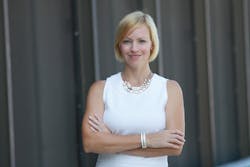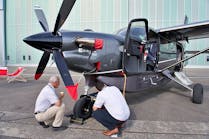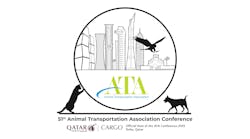Q&A with RAA President Faye Malarkey Black
A native of Pittsburgh, Ms. Black began her career in Western Pennsylvania politics working on “Get out the Vote,” field, and communications strategy teams during the 1994 and 1996 Democratic coordinated campaigns. She currently serves on the Board of Governors of the Aero Club of Washington and is a co-chair of its Foundation. She is also a member of the NextGen Institute Management Council, the RTCA Policy Board, and is an incoming member of the Transportation Research Board’s Standing Committee on Light Commercial and General Aviation.
AMT: You certainly have an impressive resume. Was there anything specific that got you interested in aviation?
FB: When I was a child, my grandfather would help a retired couple drive their car back and forth from our hometown of Pittsburgh to their winter home in Florida. He would drive the couple’s automobile down and fly back so they could avoid driving. As a working class family, this presented my family with a relatively rare opportunity for travel. My grandfather wanted to bring me along, but I was afraid to fly. So instead, we’d sit on a big log in the backyard, call it our airplane, and announce each state we “flew over” on our pretend trip. It wasn’t until I was 14 years old that I flew on anything besides that old log. We connected to a small community. I didn’t know it then, but my very first flight included a regional airline segment.
I’ve been taken with air travel ever since, but like many people, I never considered aviation as a career path that was open to me. I worked my way through college, eventually working political campaigns. This work led me to Washington and gave me my start in policy. It was quite by accident that I fell into aviation. I was doing international development work and had some extra time and a policy background, which allowed me to pick up some government affairs work for RAA. The rest is history. I fell in love with aviation and have been here ever since. I love the work. When most Americans think of air travel, they think of the legacy carriers and their heavy metal. I think about the smaller plane that took my family where we wanted to go, and I am very happy I’ve landed here.
AMT: Can you provide an overview of the current RAA organization?
FB: We refer to ourselves as the small but mighty RAA team. People are surprised to learn our core professional team in Washington numbers just six. Of course, a team of independent contractors, many of whom have been with the RAA for decades, supports us.
RAA has 25 airline members, each with a designated seat on our board of directors. Our board members possess a mutual appreciation of entrepreneurship and the competitive spirit and shelve any differences at these meetings to focus on the greater good. Our meetings are incredibly efficient and always leave me with a renewed sense of why we are doing this work.
AMT: What are the primary RAA initiatives?
FB: The “looming pilot shortage” is now in the early stages of impact. Without intervention it will worsen exponentially each year. As your readers know, the FAA implemented a rule in 2013 requiring Part 121 airline first officers to hold a full or Restricted-ATP, formerly required of PICs. While the rule change didn’t cause the pilot shortage, it further restricted access to an already shrinking pool of pilots based on metrics that don’t guarantee higher levels of experience. In fact, airline training departments have warned emphasizing an hours-based metric for hiring standards has actually led to degradation of the quality of eligible candidates, because the pilots who perform best in regional airline training programs are no longer eligible for hire. We’ve recently seen compelling data affirming these observations with the latest phase of the pilot source study (www.pilotsourcestudy.org). A key difference between where we are on this initiative now vs. our recent past is that before, we were detailing all the valid reasons that an hours-based measure of experience does not assure safety. Now, we are in a position to offer a better and safer alternative based on empirical data. It is more important than ever to pursue solutions that reconnect the broken pilot pipeline while advancing a higher level of safety. The RAA has offered a solution that delivers squarely on both objectives.
Next, RAA continues to fend off shortsighted initiatives seeking to reform ATC but failing to account for the unique and distinct role regional airlines play in the airspace. Regional airlines operate 45 percent of the U.S. flights, and provide the only source of scheduled, commercial air service to 393 U.S. airports, well over half our nation’s airports. The plan put forth earlier this year could increase costs for regional airline flight segments, putting these flights and small community air service at risk. Additionally, the plan subsumed our voice in an envisioned ATC governance body to that of the legacy carriers. Regional airlines are distinct operators, and we alone can pursue the certainty that our industry’s health and unique role will be understood and respected when it comes to control and pricing of the airspace. This year’s ATC reform plan missed the mark widely for regional airlines, and we are firmly opposed.
While much of our focus has been on pilot workforce issues, we are keenly aware of the growing shortage of aviation maintenance technicians. Investing in future workforce must be a multi-faceted effort, include all aviation professionals, and begin much earlier than we have historically begun. We hope you’ll watch this space for a job fair and recruiting event planned for 2017, designed to help connect aviation professionals of all walks with career opportunities at regional airlines.
AMT: Does the RAA board drive all RAA initiatives?
FB: Much of the work of the organization is powered by our airlines. RAA has organized standing committees, approved by our board, which focus on everything from safety, training, operations, environment, security, maintenance, and more. Committees meet regularly to discuss and advance industry best practices. In addition to these committees, the board often organizes itself into ad hoc task forces to carry out key initiatives. Board meeting agendas are set jointly by the RAA staff and current Board Chairman Linda Markham, president of Cape Air. We work closely with our membership all year long and their objectives and initiatives are well understood. We do have a defined process for reaching board positions on high profile subjects.
The role of the staff is multi-fold. In addition to managing the association’s business, we offer strategic guidance and policy expertise. We keep members abreast of issues that stand to impact the organization or the industry and make recommendations. We also serve as a conduit for our members to offer their feedback and expertise to policymakers.
AMT: What do you see as the primary issues facing the regional airline industry today?
FB: RAA and its member airlines are focused on safety above all else. RAA’s members have worked hard to contribute to the extremely safe skies we enjoy today. And yet, the environment in Washington has become very adversarial, very cynical. We are working harder than ever to break through the skepticism that hinders industry’s ability to advance sound, safety-first solutions to big challenges. Our programs must be impeccable, supported by strong data, and we must work determinedly to overcome hurdles. Assuring we can continue to do this work on behalf of our members means taking care of our brand. You’ll see us not only offering solutions that are well thought out and backed by strong data, but working hard to correct mischaracterizations and misunderstandings about what we are trying to accomplish.
AMT: How does RAA engage in these issues?
FB: That’s a great question because it’s both static and dynamic at the same time. Prima facie, the processes are the same – we interface with Congress, regulators, we carry the industry message, take part in the conversation, and bring the results back to our membership. Yet, there are exponentially more players now, more people to educate, more parties than ever with influence over the legislative and regulatory process. We’ve had to adapt and we’ve had to work harder than ever to get our message heard. You’ll certainly see more changes in this space. For example, we have a Facebook account and a twitter account, @raatweets. While we’ve had these tools for some time, this is an area into which we’re putting more energy and a renewed focus this year. These generationally relevant communication tools are imperative for success – we must fully leverage social media to stay relevant.
AMT: How does RAA interact/engage with FAA? What are the key FAA initiatives?
FB: Our team has what I’d characterize as strong, institutional relationships with FAA officials. We are an important source of information and insight on regional airlines. The same goes for Capitol Hill. I started my career with the RAA as a “lobbyist,” which most people view as an influencer of policy. My take on the role has always been that of an educator and a facilitator of conversations between the regulated industry and its regulators. Information exchange is crucial to achieving a safe and strong aviation system. Sound policy cannot happen in a vacuum. I certainly hope we’re always talking to one another. Our team takes the association’s role on various rulemaking committees very seriously, and is committed to bringing accurate information to these conversations while approaching other stakeholders' input with consideration and open-mindedness. We share a common objective in upholding the highest level of safety.
As for the FAA’s initiatives, we are passionate about the importance of FAA’s safety management systems (SMS). These programs go to the very heart of how we identify, share, and ultimately, address, risk in the system. We feel strongly that these programs have been a key contributor to our safe skies today. Regional airlines are embracing these programs enthusiastically.
AMT: What other organizations does RAA work with to strengthen RAA's initiatives and goals?
FB: Too many to name without leaving out important partners. Communities have already lost considerable air service owing to the pilot shortage, and airports and state aviation officials have been engaged and supportive of our pilot workforce solutions.
Additionally, the RAA has a dedicated Associate Member Council representing our supply company partners. We have a growing scholarship fund, and last year we were able to award three scholarships. Our associate members raise these funds and this year, we are working to establish a foundation. And, while we are distinct, we often work alongside our mainline partners to highlight the importance of commercial aviation.
Of equal importance to who we are working with at any given moment are the groups, individuals, and institutions we are willing to work with. That’s not something we see as limited. I view success as linked to our ability to work collaboratively with multiple, diverse stakeholders. We are constantly seeking new opportunities to engage.
AMT: The industry is facing a shortage of aircraft maintainers. What are RAA member airlines telling you relating to a mechanic shortage?
FB: I was at the Women in Aviation convention in March, talking to some remarkable female mechanics about what attracted them to the profession. Each spoke of the same “hook,” a variation on a theme that centered on this desire to tinker, to take things apart and put them back together. Next there was a realization that one can actually pursue this as a career maintaining aircraft. My sense is that our industry has not always had to work hard at sparking that ambition or illuminating that connection. Now we do. With maintenance professionals, we’re competing against a lot of other opportunities to tinker. But the connection itself is not magic; it’s getting out and talking to young people about a career in aviation and how they can make it work for them. Telling young people about the unprecedented investments this industry is making in its current and future workforce. The RAA plans to hold a career fair starting with our 2017 RAA Annual Convention, and we aim to make maintenance technicians a part of this outreach, too.
AMT: The annual RAA convention is a favorite of ours. What would you say is the primary goal of the RAA convention?
FB: I love to hear that it is a favorite; thank you. I still remember my first RAA convention in 1998. Entering the exhibit hall for the first time took my breath away. It still does. There is nothing quite like it. Business models have changed, and some of the faces have, too, but overwhelmingly, many of the same people take part year after year and have developed genuine friendships as a result. My view of our primary goal is to continue to foster those relationships – that sense that we are all in this together. Our annual convention offers a chance for all of us to look at the show hall and realize the work we’re doing bolsters more than just our 25 airline members and the communities they serve, but all of these supply companies too, and the workers they support.
It’s no secret our convention revenues have declined over the years and cost pressures are intense. Our convention needed modernizing. We knew we would get the best advice from the people who exhibit with us each year, so that’s where we turned for help. Through surveys and our Associate Member Council, they told us they wanted better locations to attract more participants, better timing in light of industry events, plenty of time to network, and content addressing more diverse interests. I believe we’re on our way to delivering those objectives. Starting in 2017, we are moving our dates to the fall, holding that year’s convention in stunning Palm Beach, FL. We are tweaking the schedule and flow to encourage considerably more interaction between participants.
Fortunately, attendees won’t have to wait until 2017 for many more immediate improvements. We’ve got a fantastic convention planned for Charlotte, with the NASCAR Hall of Fame evening event generating enthusiasm. Turns out, folks who like airplanes also like fast cars! Already, we’ve packed session content with a better balance of topics. Well-traveled subjects like pilot workforce will be featured, of course, but with most of our non-airline attendees involved in maintenance issues, we’ve crafted new content with their interests in mind. Again, we’ve turned to the experts; our Associate Member Council has put together two panels, one during our general session, and another at one of the multiple maintenance track sessions we have planned.
AMT: What can we expect from RAA under your leadership?
FB: I have three characteristics that I bring to my leadership style. The first is I am an optimist, the second is that I am strategic, and the last is that I’m very determined. I believe that even big problems have solutions. On the other hand, my optimism is tempered by the knowledge of today’s realpolitik; I’ve seen firsthand how the most sincere of efforts are squashed in an unfavorable political environment. Action without sound strategy behind it is worse than doing nothing at all. In addition to the politics, there is a very human element at hand, where real people with sincerely held beliefs oppose our efforts for reasons we haven’t been able to overcome despite our best efforts. The optimist in me is unwilling to give up on those relationships or on finding common ground. The realist in me acknowledges that political agendas are unlikely to change wholesale, and will always be an influence. Still, people will see what they expect to see, until we challenge those perceptions. That’s where determination comes in. We have to work for it. Our core principals, strong safety culture, and dedication to our passengers and partners have been here all along but we need to do a much better job talking about this, so people know and understand where we are coming from, as well as where we can take them.



